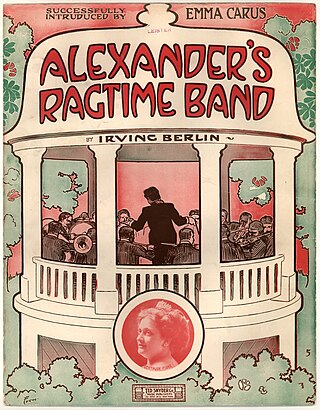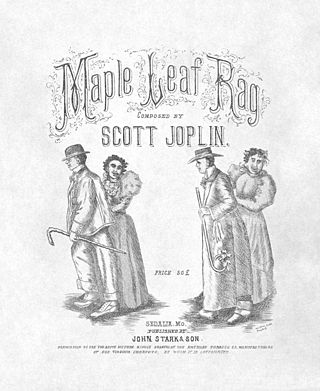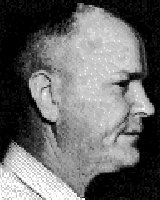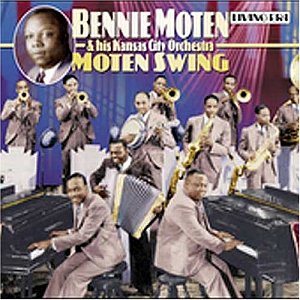Ragtime, also spelled rag-time or rag time, is a musical style that had its peak from the 1890s to 1910s. Its cardinal trait is its syncopated, or "ragged" rhythm. Ragtime was popularized during the early 20th century by composers such as Scott Joplin, James Scott and Joseph Lamb. Ragtime pieces are typically composed for and performed on piano, though the genre has been adapted for a variety of instruments and styles.

Scott Joplin was an African-American composer and pianist. Dubbed the "King of Ragtime", he composed more than 40 ragtime pieces, one ragtime ballet, and two operas. One of his first and most popular pieces, the "Maple Leaf Rag", became the genre's first and most influential hit, later being recognized as the quintessential rag. Joplin considered ragtime to be a form of classical music meant to be played in concert halls and largely disdained the performance of ragtime as honky tonk music most common in saloons.

The Original Dixieland Jass Band (ODJB) was a Dixieland jazz band that made the first jazz recordings in early 1917. Their "Livery Stable Blues" became the first jazz record ever issued. The group composed and recorded many jazz standards, the most famous being "Tiger Rag". In late 1917, the spelling of the band's name was changed to Original Dixieland Jazz Band.

"Alexander's Ragtime Band" is a Tin Pan Alley song by American composer Irving Berlin released in 1911; it is often inaccurately cited as his first global hit. Despite its title, the song is a march as opposed to a rag and contains little syncopation. The song is a narrative sequel to Berlin's earlier 1910 composition "Alexander and His Clarinet". This earlier composition recounts the reconciliation between an African-American musician named Alexander Adams and his flame Eliza Johnson as well as highlights Alexander's innovative musical style. Berlin's friend Jack Alexander, a cornet-playing African-American bandleader, inspired the title character.

The "Maple Leaf Rag" is an early ragtime musical composition for piano composed by Scott Joplin. It was one of Joplin's early works, becoming the model for ragtime compositions by subsequent composers. It is one of the most famous of all ragtime pieces. Its success led to Joplin being dubbed the "King of Ragtime" by his contemporaries. The piece gave Joplin a steady if unspectacular income for the rest of his life.

Charles Leslie Johnson was an American composer of ragtime and popular music. He was born in Kansas City, Kansas, died in Kansas City, Missouri, and lived his entire life in those two cities. He published over 300 songs in his life, nearly 40 of them ragtime compositions such as "Doc Brown’s Cakewalk", "Dill Pickles", "Apple Jack ", and "Snookums Rag". His best selling piece, a sentimental ballad called "Sweet and Low", sold over a million copies. Experts believe that had Johnson lived and worked in New York, he would be included alongside Scott Joplin, James Scott, and Joseph Lamb as one of the greatest ragtime composers. He wrote more than the other three combined and exemplified a greater range of talent, composing waltzes, tangos, cakewalks, marches, novelty pieces, and other types of music popular at that time.

Euday Louis Bowman was an American pianist and composer of ragtime and blues who represented the style of Texas Ragtime. He is chiefly remembered as the composer of the highly popular "Twelfth Street Rag", a ragtime composition from 1914 out of a series of rags that Bowman wrote during or after a period in which he worked as a pianist in bordellos of Kansas City. These pieces, including "Sixth Street Rag", "Tenth Street Rag", "Eleventh Street Rag" and "Twelfth Street Rag," were named after streets of Fort Worth's redlight district.

Arthur Francis Collins was an American baritone who was one of the pioneer recording artists, regarded in his day as "King of the Ragtime Singers".

"The Entertainer" is a 1902 classic piano rag written by Scott Joplin.

"Tiger Rag" is a jazz standard that was recorded and copyrighted by the Original Dixieland Jass Band in 1917. It is one of the most recorded jazz compositions. In 2003, the 1918 recording of "Tiger Rag" was entered into the U.S. Library of Congress National Recording Registry.

The Carol Lou Trio was a jazz combo which gained modest popularity in the mid-eastern United States between the 1950s and 1970s, and international distribution of its few recordings. The group was headed by Carol Lou Hedges, whose modest demeanor belied her piano virtuosity and swinging style. Husband and bassist John Hedges was the other permanent member of the group, with various drummers having been employed, including future drummer for the Count Basie band and Tony Bennett, Harold Jones (drummer) in 1956-57. The trio's reputation spread mostly by word of mouth, but it did release several singles and one album.
"Panama" is a jazz standard. It is by William Henry Tyers, originally entitled "Panama, a Characteristic Novelty", published in 1912.

"If I Could Be with You (One Hour Tonight)" is a popular song, with music by James P. Johnson and lyrics by Henry Creamer. Published in 1926, the song was first recorded by Clarence Williams' Blue Five with vocalist Eva Taylor in 1927. It was popularized by the 1930 recording by McKinney's Cotton Pickers, who used it as their theme song and by Louis Armstrong's record for Okeh Records (catalogue No.41448), both of which featured in the charts of 1930. Armstrong's recording of "If I Could Be with You" is defined by his sparse vocal style and ornamental virtuosic trumpet-playing.

The "Black and White Rag" is a 1908 ragtime composition by George Botsford.
Dixieland jazz, also referred to as traditional jazz, hot jazz, or simply Dixieland, is a style of jazz based on the music that developed in New Orleans at the start of the 20th century. The 1917 recordings by the Original Dixieland Jass Band, fostered awareness of this new style of music.
Snake Rag is a 1923 Dixieland jazz standard composed by Joseph "King" Oliver of King Oliver's Creole Jazz Band. It features Oliver and Louis Armstrong on cornet, Honoré Dutrey on trombone, Johnny Dodds on clarinet, Lil Hardin on piano, Baby Dodds on drums, and William Manuel Johnson on banjo. The rag was a result of improvisation during a session at Richmond, Indiana on April 6, 1923.

"Moten Swing" is a 1932 jazz standard by Bennie Moten and his Kansas City Orchestra. It was an important jazz standard in the move towards a freer form of orchestral jazz and the development of Swing music. Moten and his Orchestra, which included Count Basie on piano, achieved much success with it, although the song is most associated with Basie's Count Basie Orchestra, who recorded it in 1940.

Lyons and Yosco were an American comedy duo, consisting of Italian American musicians George Lyons and Bob Yosco. They were defined by the Ottawa Evening Journal "the finest pair of Italian street musicians playing in the Vaudeville ranks." They toured the United States from 1909 into 1923, doing a musical and comedy act. The News Journal described their performance, saying they were "the best vocalists and instrumentalists of the street variety on the stage, proved intensely interesting, while their droll comedy kept the audience laughing much of the time."














